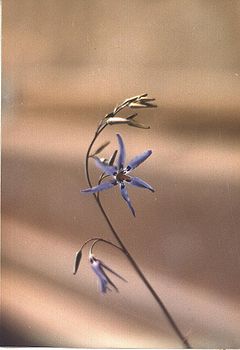Tecophilaeaceae


Voir le texte pour plus d'information.
Classification APG III (2009)

| Clade | Angiospermes |
|---|---|
| Clade | Monocotylédones |
| Ordre | Asparagales |
Famille
Leyb. (1862)
La famille des Técophilaeacées regroupe des plantes monocotylédones. Elle comprend environ deux douzaines d'espèces réparties en 7-9 genres.
Ce sont des plantes herbacées, pérennes.
Étymologie
Le nom vient du genre Tecophilaea donné par le botaniste italien Luigi Aloysius Colla (1766–1848) en hommage à sa fille, artiste botanique, Tecophila Colla-Billotti[1]. Billotti qui trouva cette plante en 1836, en attribua le genre sur la suggestion du physicien et botaniste Carlo Luigi Giuseppe Bertero (1789-1831).
Classification
En classification phylogénétique APG II (2003)[2] cette famille inclut le genre Cyanastrum qui est accepté comme la famille Cyanastracées dans la classification classique de Cronquist (1981)[3].
Liste des genres
Selon World Checklist of Selected Plant Families (WCSP) (16 avr. 2010)[4] :
- Conanthera Ruiz & Pav. (1802)
- Cyanastrum Oliv. (1891)
- Cyanella (en) Royen ex L. (1754)
- Eremiolirion (en) J.C.Manning & F.Forest (2005)
- Kabuyea (en) Brummitt (1998)
- Odontostomum Torr., Pacif. Railr. Rep. Parke (1857)
- Tecophilaea (en) Bertero ex Colla (1836)
- Walleria (en) J.Kirk (1864)
- Zephyra (en) D.Don (1832)
Selon Angiosperm Phylogeny Website (18 mai 2010)[5] :
- Conanthera Ruiz & Pavon
- Cyanastrum Oliv.
- Cyanella Royen ex L.
- Odontostomum Torr.
- Tecophilaea (en) Bertero ex Colla
- Walleria J.Kirk
- Zephyra D.Don
Selon NCBI (16 avr. 2010)[6] :
- Conanthera
- Cyanastrum
- Cyanella
- Kabuyea
- Odontostomum
- Tecophilaea
- Walleria
- Zephyra
Selon DELTA Angio (16 avr. 2010)[7] :
- Conanthera
- Cyanella
- Lanaria
- Lophiola
- Odontospermum
- Tecophilaea
- Walleria
- Zephyra
Liste des espèces
Selon World Checklist of Selected Plant Families (WCSP) (16 avr. 2010)[4] :
- genre Conanthera Ruiz & Pav. (1802)
- Conanthera bifolia Ruiz & Pav. (1802)
- Conanthera campanulata Lindl. (1826)
- Conanthera parvula (Phil.) Muñoz-Schick (2000)
- Conanthera trimaculata (D.Don) F.Meigen (1893)
- Conanthera urceolata Ravenna (1988)
- genre Cyanastrum Oliv. (1891)
- Cyanastrum cordifolium Oliv. (1891)
- Cyanastrum goetzeanum Engl. (1900)
- Cyanastrum johnstonii Baker (1898)
- genre Cyanella Royen ex L. (1754)
- Cyanella alba L.f. (1782)
- Cyanella aquatica Oberm. ex G.Scott (1991)
- Cyanella cygnea G.Scott (1991)
- Cyanella hyacinthoides Royen ex L., Gen. Pl. ed. 5 (1754)
- Cyanella lutea L.f. (1782)
- Cyanella orchidiformis Jacq. (1790)
- Cyanella ramosissima (Engl. & Krause) Engl. & K.Krause (1921)
- genre Eremiolirion J.C.Manning & F.Forest (2005)
- Eremiolirion amboense (Schinz) J.C.Manning & Mannh. (2005)
- genre Kabuyea Brummitt (1998)
- Kabuyea hostifolia (Engl.) Brummitt (1998)
- genre Odontostomum Torr., Pacif. Railr. Rep. Parke (1857)
- Odontostomum hartwegii Torr., Pacif. Railr. Rep. Parke (1857)
- genre Tecophilaea Bertero ex Colla (1836)
- Tecophilaea cyanocrocus Leyb. (1862)
- Tecophilaea violiflora Bertero ex Colla (1836)
- genre Walleria J.Kirk (1864)
- Walleria gracilis (Salisb.) S.Carter (1962)
- Walleria mackenziei J.Kirk (1864)
- Walleria nutans J.Kirk (1864)
- genre Zephyra D.Don (1832)
- Zephyra compacta C.Ehrh. (2001)
- Zephyra elegans D.Don (1832)
Selon NCBI (16 avr. 2010)[6] :
- genre Conanthera
- Conanthera biflora
- Conanthera campanulata
- Conanthera trimaculata
- genre Cyanastrum
- Cyanastrum cordifolium
- genre Cyanella
- Cyanella capensis
- Cyanella hyacinthoides
- genre Kabuyea
- Kabuyea hostifolia
- genre Odontostomum
- genre Tecophilaea
- Tecophilaea cyanocrocus
- Tecophilaea violiflora
- genre Walleria
- Walleria gracilis
- Walleria mackenzii
- genre Zephyra
- Zephyra elegans
Notes et références
- ↑ (en) Maarten J M Christenhusz, Michael F Fay et Mark W. Chase, Plants of the World : An Illustrated Encyclopedia of Vascular Plants, Chicago, The University of Chicago Press, , 792 p. (ISBN 978-0-2265-2292-0), p. 165
- ↑ (en) Angiosperm Phylogeny Group, « An update of the Angiosperm Phylogeny Group classification for the orders and families of flowering plants: APG II », Botanical Journal of the Linnean Society, Wiley-Blackwell, Linnean Society of London et OUP, vol. 141, no 4, , p. 399–436 (ISSN 0024-4074 et 1095-8339, DOI 10.1046/J.1095-8339.2003.T01-1-00158.X).

- ↑ (en) Arthur Cronquist, An Integrated System of Classification of Flowering Plants, New York, Columbia University Press, (ISBN 0-231-03880-1, OCLC 1136076363, lire en ligne).

- ↑ a et b WCSP. World Checklist of Selected Plant Families. Facilitated by the Royal Botanic Gardens, Kew. Published on the Internet ; http://wcsp.science.kew.org/, consulté le 16 avr. 2010
- ↑ Stevens, P. F. (2001 onwards). Angiosperm Phylogeny Website. Version 14, July 2017 [and more or less continuously updated since]." will do. http://www.mobot.org/MOBOT/research/APweb/, consulté le 18 mai 2010
- ↑ a et b NCBI, consulté le 16 avr. 2010
- ↑ DELTA Angio, consulté le 16 avr. 2010
Liens externes
Sur les autres projets Wikimedia :
- Tecophilaeaceae, sur Wikimedia Commons
- (en) Référence World Checklist of Selected Plant Families (WCSP) : Tecophilaeaceae
- (en) Référence Angiosperm Phylogeny Website : Tecophilaeaceae (+ liste genres)
- (en) Référence DELTA Angio : Tecophilaeaceae Leybold
- Voir aussi Liliaceae
- (en) Référence Paleobiology Database : Tecophilaeaceae Leybold
- (en) Référence NCBI : Tecophilaeaceae (taxons inclus)
- (en) Référence GRIN : famille Tecophilaeaceae Leyb. (+liste des genres contenant des synonymes)
 Portail de la botanique
Portail de la botanique











